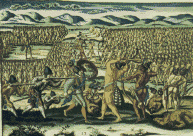Incursions in North America
The French, Spanish, Portuguese, and English arrived in North America in the 16th century, sporadically and in small numbers. Fishermen plied their trade off the Newfoundland coast from around 1500. Some Europeans hoped to find an alternative route to Asia (the Northwest Passage), wealthy civilizations, or precious metals, but few found what they sought. They did not however, confront an untamed wilderness but rather people who often lived in villages and towns.
The European intruders depended almost entirely on the indigenous people, who provided them food and guides, sometimes under duress. They made few serious attemps to settle in the early years. Frequently, the most enduring impact of their expeditions was negative. Their diseases devastated native populations, and violence and wholesale commandeering of food supplies left a legacy of fear and hostility.
The Spanish and French Disrupt Life in Florida
Almost from the outset, European arrivals in the Florida peninsula produced violent confrontations. The Spanish came first, presumably as an extension of slave raiding in the Caribbean islands. Ponce de Leon's expeditions, in 1513 and 1521, failed because of Timucua and Calusa resistance. Subsequent Spanish expeditions moved on without fouding any permanent settlements until St. Augustine was established in 1565.
In the early 1560s, French Huguenots established a colony at the mouth of the Saint Johns River. Jacques Le Moyne, who mapped the area and wrote an account of his experiencies, survived the 1565 Spanish attack that destroyed the French colony. Engravings based on his drawings show the site in Florida where the French first landed; Timucua men and women carrying fruit; and a battle scene in which French soldiers aided their ally Outina against his enemy Potanou.
- Promontory of Florida

The French initially touched the Florida coast near the St. Mary's River in the early 1560s, attempted settlements in the region, created alliances with the various Indian settlements, and eventually were annihilated by the Spanish in 1565.
- Outina over Potanou

The contacts of the French with the Timucua peoples of what is now northern Florida were documented by Jacques Le Moyne de Morgues. In this view the alliance of the French with the Chief Outina is used to overwhelm his arch-enemy Potanou.

 This is the last section of Europe Claims America . For final thoughts on 1492: An Ongoing Voyage, please see The Epilogue.
This is the last section of Europe Claims America . For final thoughts on 1492: An Ongoing Voyage, please see The Epilogue.
You may also use the Outline.



 This is the last section of Europe Claims America . For final thoughts on 1492: An Ongoing Voyage, please see
This is the last section of Europe Claims America . For final thoughts on 1492: An Ongoing Voyage, please see